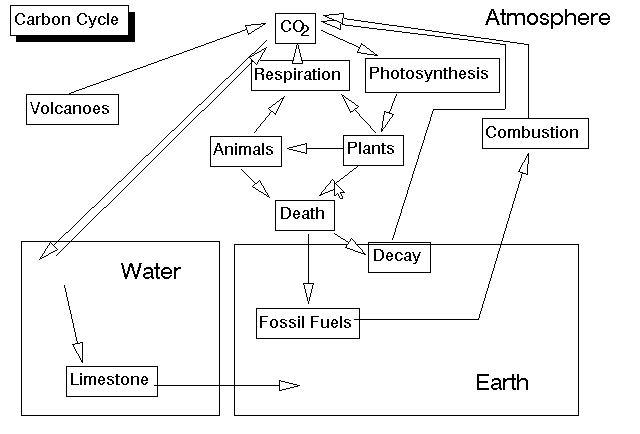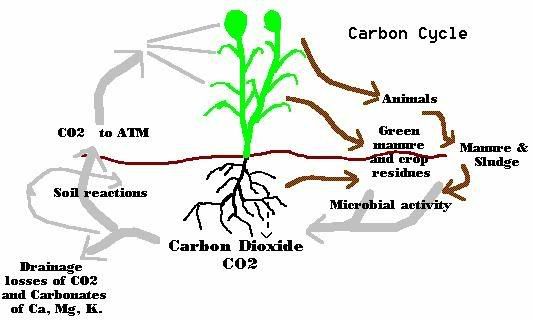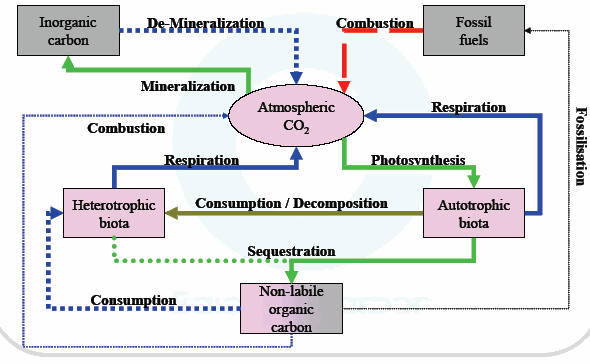CSS Forums
Saturday, April 20, 2024
03:33 PM (GMT +5)
03:33 PM (GMT +5)
|
#71
|
|||
|
|||
|
Quote:
The Bhatti Sons EDS book that I am using says that "see chapter Human Physiology" for the answer to this question and the chapter says merely anything about it so thanks to bhatti sahab The internet is also confusing because I cannot get from the question if it is talking about the Human System in the biological meaning or the ecological meaning or still there is something else P.S - I request the qualifiers to kindly look into this question |
| The Following User Says Thank You to Viceroy For This Useful Post: | ||
mariyah ahmed (Wednesday, May 13, 2009) | ||
|
#72
|
|||
|
|||
|
Quote:
This is about hormonal feedback mechanism,it means if some hormones promotes or stimulates,there should be some other hormone checking it. i.e negative and positive feedback. you can give e.g of FsH and estrogen TSH and Thyroxine etc if you have ilimi intermediate Fsc book ,its described very well in coordination chapter Page 122. you can check it. |
| The Following 2 Users Say Thank You to AFRMS For This Useful Post: | ||
Viceroy (Wednesday, May 13, 2009), ramshakhan (Thursday, May 14, 2009) | ||
|
#73
|
||||
|
||||
|
Homeostatic feedback mechanisms
Many endocrine glands are linked to neural control centers by homeostatic feedback mechanisms. The two types of feedback mechanisms are negative feedback and positive feedback. Negative feedback decreases the deviation from an ideal normal value, and is important in maintaining homeostasis. Most endocrine glands are under the control of negative feedback mechanisms. Negative feedback mechanisms act like a thermostat in the home. As the temperature rises (deviation from the ideal normal value), the thermostat detects the change and triggers the air-conditioning to turn on and cool the house. Once the temperature reaches its thermostat setting (ideal normal value), the air conditioning turns off. An example of negative feedback is the regulation of the blood calcium level. The parathyroid glands secrete parathyroid hormone, which regulates the blood calcium amount. If calcium decreases, the parathyroid glands sense the decrease and secrete more parathyroid hormone. The parathyroid hormone stimulates calcium release from the bones and increases the calcium uptake into the bloodstream from the collecting tubules in the kidneys. Conversely, if blood calcium increases too much, the parathyroid glands reduce parathyroid hormone production. Both responses are examples of negative feedback because in both cases the effects are negative (opposite) to the stimulus. Positive feedback mechanisms control self-perpetuating events that can be out of control and do not require continuous adjustment. In positive feedback mechanisms, the original stimulus is promoted rather than negated. Positive feedback increases the deviation from an ideal normal value. Unlike negative feedback that maintains hormone levels within narrow ranges, positive feedback is rarely used to maintain homeostatic functions. An example of positive feedback can be found in childbirth. The hormone oxytocin stimulates and enhances labor contractions. As the baby moves toward the vagina (birth canal), pressure receptors within the cervix (muscular outlet of uterus) send messages to the brain to produce oxytocin. Oxytocin travels to the uterus through the bloodstream, stimulating the muscles in the uterine wall to contract stronger (increase of ideal normal value). The contractions intensify and increase until the baby is outside the birth canal. When the stimulus to the pressure receptors ends, oxytocin production stops and labor contractions cease http://www.besthealth.com/besthealth...o_sys_fin.html rgds |
| The Following 4 Users Say Thank You to dr.atifrana For This Useful Post: | ||
mariyah ahmed (Wednesday, May 13, 2009), Viceroy (Wednesday, May 13, 2009), ramshakhan (Thursday, May 14, 2009), xaara~hussain (Monday, February 14, 2011) | ||
|
#74
|
||||
|
||||
|
@Mohsin
some corrections and improvement in the post number 67.some related topics have also been added. Aviculture is the practice of keeping and often breeding birds and the culture that forms around it. Trout are a number of species of freshwater fish belonging to the Salmoninae subfamily of the Salmonidae family. Salmon belong to some of the same genera as trout but, unlike most trout, most salmon species spend almost all their lives in salt water. Cusec is a measure of flow rate and is informal shorthand for cubic foot per second (28.317 liters per second). In the United States it is generally applied to water flow, particularly in rivers. Proteinsare broken down in the stomach during digestion by enzymes known as proteases into smaller polypeptides to provide amino acids for the organism, including the essential amino acids that the organism cannot biosynthesize itself. Aside from their role in protein synthesis, amino acids are also important nutritional sources of nitrogen. Proteins, like carbohydrates, contain 4 kilocalories per gram as opposed to lipids which contain 9 kilocalories and alcohols which contain 7 kilocalories. The liver, and to a much lesser extent the kidneys, can convert amino acids used by cells in protein biosynthesis into glucose by a process known as gluconeogenesis. The amino acids leucine and lysine are exceptions. The four blood types are known as A, B, AB, and O. Blood type A contains red blood cells that have a substance A on their surface. This type of blood also contains an antibody directed against substance B, found on the red cells of persons with blood type B. Type B blood contains the reverse combination. Serum of blood type AB contains neither antibody, but red cells in this type of blood contain both A and B substances. In type O blood, neither substance is present on the red cells, but the individual is capable of forming antibodies directed against red cells containing substance A or B. If blood type A is transfused into a person with B type blood, anti-A antibodies in the recipient will destroy the transfused A red cells. Because O type blood has neither substance on its red cells, it can be given successfully to almost any person. Persons with blood type AB have no antibodies and can receive any of the four types of blood; thus blood types O and AB are called universal donors and universal recipients, respectively. Other hereditary blood-group systems have subsequently been discovered. The hereditary blood constituent called Rh factor is of great importance in obstetrics and blood transfusions because it creates reactions that can threaten the life of newborn infants. More than twenty additional blood types have been discovered. Their primary importance is in legal cases involving proof of paternity A biopsy is a medical test involving the removal of cells or tissues for examination. It is the removal of tissue from a living subject to determine the presence or extent of a disease. The tissue is generally examined under a microscope by a pathologist, and can also be analyzed chemically. Difference b/w Ape and monkey Physical characteristics
Monkeys generally prefer to eat fruits, leaves, insects and grass while Apes eat fruits, grass and small invertebrate animals. Habitat Monkeys are mostly arboreal while Apes are semi terrestrial. Lifespan Monkeys can live upto 30 years while Apes can live for 60 years. Geographical Distribution While apes are native to Asia and Africa, Monkeys can be found in Asia, Africa and South America. Similarity to Humans Apes are closely related to humans. Humans form part of the family of Hominidae to which Apes also belong. Hence there are close similarities between the two. Monkeys are primates like humans but still differ a lot. This is because of their relative distance from each other in the evolution cycle. Endangered species One specie of Apes is considered endangered while that is not so with Monkeys. Most species of Monkeys are not considered endangered http://www.diffen.com/difference/Ape_vs_Monkey for diff b/w animals ,this link is good http://www.diffen.com/ Hydrostatics is about the pressures exerted by a fluid at rest. Any fluid is meant, not just water. diff b/w hydrostatics and hydrodynamics Hydrostatics, the consideration of liquids at rest, involves problems of buoyancy and flotation, pressure on dams and submerged devices, and hydraulic presses. Hydrodynamics, the study of liquids in motion, is concerned with such matters as friction and turbulence generated in pipes by flowing liquids, the flow of water over weirs and through nozzles, and the use of hydraulic pressure in machinery. The relative incompressibility of liquids is one of its basic principles. What is the difference between a ‘DAM' and a ‘BARRAGE’? 2. The following Answer has been given by JAYPEE Construction Company under their web site:http://www.jhpl.com/hp-faq.htm Both the dam and barrage are barriers constructed across a river or natural water course for diverting water into a canal mainly for purposes of irrigation, water supply etc. or into a channel or a tunnel for generation of power. In case of a barrage, its entire length across the river i.e. between the banks is provided with gates having their bottom sill near the river bed level. Thus, the storage behind the barrage is solely created by the height of the gates. The dam on the other hand has spillway gates almost near its top level and the storage behind the dam is mainly due to the height of concrete structure and partially due to the gate height. In both the cases, however, the number and size of gates is adequate to pass the design flood during monsoons. Improvement and corrections are acceptible. rgds Last edited by Last Island; Thursday, May 14, 2009 at 11:34 PM. |
| The Following 3 Users Say Thank You to dr.atifrana For This Useful Post: | ||
AFRMS (Thursday, May 14, 2009), Viceroy (Thursday, May 14, 2009), ramshakhan (Thursday, May 14, 2009) | ||
|
#75
|
||||
|
||||
|
7. Write short notes on five of the following:
(i) Antibody (ii) Blood group (iii) Carbon cycle (iv) Nitrogen cycle (v) Scavenger (vi) Reaction time (vii) Photosynthesis (viii) Starfish 1. Antibody: Antibody, any of perhaps a million kinds of normally occurring protein molecules that are produced in the body of cells called lymphocytes and that act primarily as a defense against invasion by foreign substances (antigens). An important component of the immune system, antibodies are found in the blood of all vertebrates, in the fraction of the blood called gamma globulin the above paragraph is enough for defination, for detail ...some more paragraphs. Common antigens are the protein components of bacteria and viruses. These antigens may enter the body during infection or may be deliberately introduced by vaccination (Immunization) in order to stimulate the production of antibodies. The binding of antibodies to the surfaces of bacteria, viruses, or toxins can neutralize and eliminate these harmful substances in any or all of three ways: (1) by directly inactivating them, (2) by enabling other blood cells to engulf and destroy them (Phagocytosis), and/or (3) by weakening their surfaces and rendering them vulnerable to destruction by other blood proteins (collectively called complement). The five known classes of antibody are distinguished by the letters M, G, E, A, and D; all are preceded by the abbreviation Ig for immunoglobulin, another name for antibody. IgM is the first antibody made by newborns and the first made during an infection. IgG is the predominant antibody in serum; it is made on the second exposure to an antigen. IgE is associated with allergy. IgA is found in saliva and mother's milk. The role of IgD is not known. rgds |
| The Following 3 Users Say Thank You to dr.atifrana For This Useful Post: | ||
dua... (Thursday, April 22, 2010), Engr.Aftab (Friday, May 15, 2009), ramshakhan (Saturday, May 16, 2009) | ||
|
#76
|
||||
|
||||
|
Carbon Cycle :
(ecology), in ecology, the cycle of carbon usage by which energy flows through Earth’s ecosystem. The basic cycle begins when photosynthesizing plants (Photosynthesis) use carbon dioxide (CO2) found in the atmosphere or dissolved in water. Some of this carbon is incorporated in plant tissue as carbohydrates, fats, and protein; the rest is returned to the atmosphere or water primarily by aerobic respiration. Carbon is thus passed on to herbivores that eat the plants and thereby use, rearrange, and degrade the carbon compounds. Much of it is given off as CO2, primarily as a by-product of aerobic respiration, but some is stored in animal tissue and is passed on to carnivores feeding on the herbivores. Ultimately, all the carbon compounds are broken down by decomposition, and the carbon is released as CO2 to be used again by plants. rgds |
| The Following 2 Users Say Thank You to dr.atifrana For This Useful Post: | ||
dua... (Thursday, April 22, 2010), ramshakhan (Saturday, May 16, 2009) | ||
|
#77
|
|||
|
|||
|
Carbon Cycle .................................................. ........   |
| The Following 3 Users Say Thank You to AFRMS For This Useful Post: | ||
dr.atifrana (Friday, May 15, 2009), Engr.Aftab (Friday, May 15, 2009), ramshakhan (Saturday, May 16, 2009) | ||
|
#78
|
||||
|
||||
|
SCAVENGERS
Scavenging, or necrophagy, is a carnivorous feeding behaviour in which a predator consumes corpses or carrion that were not killed to be eaten by the predator or others of its species. Scavengers play an important role in the ecosystem by contributing to the decomposition of dead animal remains. Decomposers complete this process, by consuming the remains left by scavengers. Well known scavengers include vultures, burying beetles, blowflies, yellowjackets, and raccoons. Many large carnivores that hunt regularly, such as hyenas and lions, will scavenge if given the chance or use their size and ferocity to intimidate the original hunters. Animals which consume feces, such as dung beetles, are referred to as coprovores. Animals which primarily consume dead plants are referred to as detritivores. The eating of carrion from the same species is referred to as cannibalism RGDS |
| The Following User Says Thank You to dr.atifrana For This Useful Post: | ||
AFRMS (Saturday, May 16, 2009) | ||
|
#79
|
||||
|
||||
|
Starfish, also sea star, common name for 5 orders and about 1500 living species of marine invertebrate animals characterized by radially arranged arms bearing locomotory tube feet. Some starfish are only 1 to 2 cm (0.4 to 0.8 in) wide as adults, but others are as much as 65 cm (26 in) wide. The group is abundant at all depths of the ocean. Sea stars are echinoderms belonging to the class Asteroidea Sea stars exhibit a superficially radial symmetry. They typically have five "arms" which radiate from a central disk (pentaradial symmetry). possess a hydraulic water vascular system that aids in locomotion. The water vascular system has many projections called tube feet on the ventral face of the sea star's arms which function in locomotion and aid with feeding. Sea stars usually hunt for shelled animals such as oysters and clams. They have two stomachs. One stomach is used for digestion, and the second stomach can be extended outward to engulf and digest prey. This feature allows the sea star to hunt prey that is much larger than its mouth would otherwise allow. Sea stars are able to regenerate lost arms. A new sea star may be regenerated from a single arm attached to a portion of the central disk. rgds |
| The Following 2 Users Say Thank You to dr.atifrana For This Useful Post: | ||
AFRMS (Saturday, May 16, 2009), khan Shaheer (Saturday, February 16, 2013) | ||
|
#80
|
|||
|
|||
|
Star Fish .................................................. ...... Last edited by AFRMS; Saturday, May 16, 2009 at 10:10 AM. Reason: formatting |
| The Following 2 Users Say Thank You to AFRMS For This Useful Post: | ||
dr.atifrana (Saturday, May 16, 2009), khan Shaheer (Saturday, February 16, 2013) | ||
 |
«
Previous Thread
|
Next Thread
»
|
|
 Similar Threads
Similar Threads
|
||||
| Thread | Thread Starter | Forum | Replies | Last Post |
| English Grammar (Beginner`s Classes) | Sureshlasi | Grammar-Section | 53 | Thursday, January 20, 2022 09:10 PM |
| Lets solve IR MCQs from the past papers | dr.atifrana | International Relations | 38 | Monday, March 08, 2021 03:54 PM |
| development of pakistan press since 1947 | Janeeta | Journalism & Mass Communication | 15 | Tuesday, May 05, 2020 03:04 AM |
| Guide to Grammar and Writing | Faryal Shah | Grammar-Section | 18 | Wednesday, February 13, 2013 11:13 PM |













